BISAC NAT010000 Ecology
BISAC NAT045050 Ecosystems & Habitats / Coastal Regions & Shorelines
BISAC NAT025000 Ecosystems & Habitats / Oceans & Seas
BISAC NAT045030 Ecosystems & Habitats / Polar Regions
BISAC SCI081000 Earth Sciences / Hydrology
BISAC SCI092000 Global Warming & Climate Change
BISAC SCI020000 Life Sciences / Ecology
BISAC SCI039000 Life Sciences / Marine Biology
BISAC SOC053000 Regional Studies
BISAC TEC060000 Marine & Naval
On March 11, 2011 the largest earthquake to hit Japan occurred. This magnitude 9.0 earthquake triggered a huge tsunami and killed 2,563 people. It led to the nuclear disaster at nuclear power plant in Fukushima. It was classified as a level 7 event - the same as Chernobyl. In our area we also have nuclear power plants and we are expected to have an earthquake which is estimated to be much larger than the one encountered on March of 2011. Through funding of 30 billion Yen we are building a 13m high seawall stretching 17.5km from the Tenryu estuary to Lake Hamana which is an enclosed coastal sea. In cooperation with our citizens we are planting trees on its slopes to help protect the natural landscape and to keep to a minimum any damage from the next tsunami. Risk management at a global scale due to Climate Change is very important concern involving our children's future and happiness. Global-warming prevention education is crucial for the survival of mankind. This is because there is a possibility of falling into a huge crisis that we cannot get out of. I would like to introduce my practical environmental education for the past 25 years at a technical high school and also introduce the ideas of two great Japanese educators, Tsunesaburo Makiguchi and Daisaku Ikeda. Furthermore, I would like to refer to the importance of global citizens through education for global warming prevention which is based on the way of thinking of Dr. Ikeda which is called "Human Revolution".
"Human Revolution", Global Citizen, Sustainable Global Revolution, Climate Change
I. INTRODUCTION
According to the IPCC Fifth Assessment Synthesis Report released in November 2014, climate change may cause a "serious, pervasive and irreversible" impact on human society and nature. With the current speed of CO2 emission, it is predicted that we will exceed the limit in only 30 more years.
"Global warming" is an environmental problem at a global scale of the utmost importance because it threatens "human beings' right to life. Therefore, I believe that the global warming issue is the most important problem confronting our children's future and happiness. So I believe that global-warming-prevention education is very important for mankind.
This report is based on practical research and the educational way of training of engineers to be able to consider the environment and nature.
I would like to introduce my style of teaching practical environmental education for the past 25 years at a public industrial high school in Japan, and go into the view-points of two great educators in Japan. Furthermore, I would like to go into the importance of individual citizens becoming global citizens through education for global-warming-prevention which is based on 'Human Revolution'.
Since 1991, our school has been working on environmental education and activities. Our practical environmental education at Hamamatsu Johoku Technical High School is based on “A Geography of Human Life” written by Tsunesaburo Makiguchi in 1903 [1]. He was a great geographer and educator in Japan.
In Daisaku Ikeda’s (Maguchi’s disciple) view, global peace and a sustainable world depend ultimately on a self-directed transformation within the life of the individual, rather than on social or structural reforms alone. This idea is called “Human Revolution” and expressed most succinctly in a passage in his best-known work, Ikeda’s novelization of “The Human Revolution” in 1965 [2]: “A great inner revolution in just a single individual will help achieve a change in the destiny of a nation and, further, will enable a change in the destiny of all humankind.” Ikeda’s ideas basis for our environmental education program.
Our chief activities are 1)volunteer activity to protect nature, 2) global-warming-prevention education, 3) disaster prevention education, 4) careful manufacturing practices to protect nature and the environment, 5) recycling activities, 6)Eco-tour, 7)environmental education through NIE (Newspapers in Education), 8) replanting forests in five areas according to their original natural vegetation, 9)conserving the natural surroundings of Lake Hamana, 10) installation of an internal auditor training course for ISO14001 prior to any other technical high school in Japan (Fig.1).
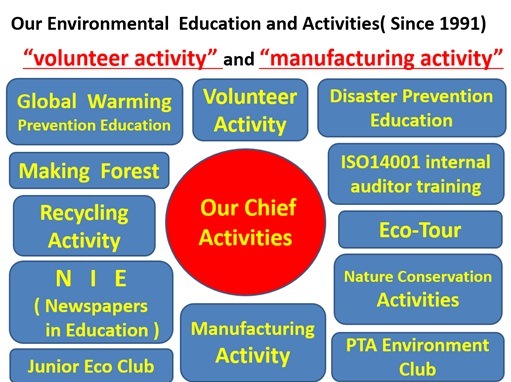
Fig. 1. Our chief environmental education activities of our school.
Our activities have received commendations from three cities and six towns around Lake Hamana, Shizuoka Prefecture, and the Japanese Government. And my global-warming-prevention education program was recognized by the Ministry of Environment of Japan with the “Minister of the Environment Award for our global warming prevention activities”.
The spread of environmental education can produce 'the enlightened global citizen'. These enlightened global citizens are able to think deeply about the future of our children on this planet. Education is able to create a new sense of value. This new value induces people's action to create a new society. A nation's educational system determines the future of a nation. Although this idea may sound simple, I believe it is the best method that can produce the greatest results.
II. THE GREAT EDUCATIONAL THOUGHT OF
TSUNESABURO MAKIGUCHI AND DAISAKU IKEDA
Our practical environmental education in Hamamatsu Johoku Technical High School is based on “A Geography of Human Life”. In 1903,”A Geography of Human Life” (Jinsei Chirigaku) was written by TSUNESABURO MAKIGUCHI (1871-1944) (Fig.2). In his book, he wrote about the evolution of competition on the earth. The competition changes to humanitarian competition from military competition, political competition and economic competition.

Our environmental education activity is based upon the three principals of Tsunesaburo Makiguchi .
- Tsunesaburo Makiguchi suggested that as the historical possibilities of military, political and economic competition would exhaust themselves in the future, humanitarian competition would take a central place in human affairs [3].
- Tsunesaburo Makiguchi represented a uniting of the private and public good through full commitment to the life of the society. And he defined education for creative living through sharing in the trials and successes of other persons and our community. This is the "win-win relationship." This relationship is needed in the world right now [4].
- Tsunesaburo Makiguchi stated that the purpose of education is the realization of children's happiness.
He wrote about these things in books and scriptures about 110 years ago. The Teachers College Press of Columbia University published the book Ethical Visions of Education. The book is contains the ideas of 10 people including Makiguchi Tsunesaburo and some of the 20th century's most dynamic and courageous educational philosophers from diverse cultural and historical perspectives: John Dewey of the United States, Paulo Freire of Brazil, W.E.B. Du Bois of the United States, Tsunesaburo Makiguchi of Japan, Jane Addams of the United States, Tao Xingzhi of China, Maria Montessori of Italy, Rabindranath Tagore of India, Rudolf Steiner of Austria, and Albert Schweitzer of France.
Daisaku Ikeda is the president of Soka Gakkai International (SGI) which has 12 million members in 192 countries and territories, and founder of several educational, cultural and peace research institutions. Daisaku Ikeda was Tsunesaburo Makiguchi’s disciple. Daisaku Ikeda said that activities and movement of all environmental protection will eventually start from that change in behavior and change in the mind of man himself. And so we will focus on the movement of environmental education. In 1965 he began writing his serialized novel, “The Human Revolution” (Daisaku Ikeda, 1965), and he wrote very famous sentence "A great inner revolution in just a single individual will help achieve a change in the destiny of a nation and, further, will enable a change in the destiny of all humankind." (Fig.3)
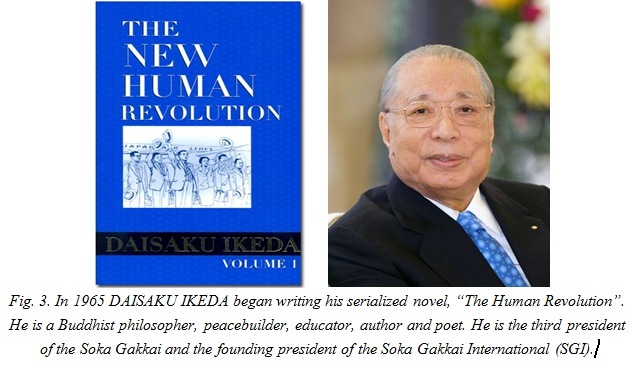
Daisaku Ikeda, with the British historian Arnold Toynbee, published a collection of books chronicling the conversations and subjective thoughts of world leaders and academic experts concerning world affairs of their time.
Recently Daisaku Ikeda collaborated with Dr. Ernst Ulrich von Weizsäcker who is a famous environmental activist in the global environment scholastic community. He is also the current co-chairman of the policy think tank "Club of Rome" which published "The Limits to Growth" in 1972.
Their dialogue has rung true and has been carried across the Great East Japan Earthquake from March 2010 to April 2014. Throughout their dialogue, they have shared common concerns for a sustainable future. And they have concurred on three points (Fig.4).
- Understanding the concept of "Human Revolution" is crucial to overcoming global issues and transforming society.
- Earth Revolution begins with the "Human Revolution".
- The philosophy of "Human Revolution" is an extremely important.
In addition, Dr. Weizsäcker was said that "Human Revolution" is a philosophy that will become the foundation of any type of education.
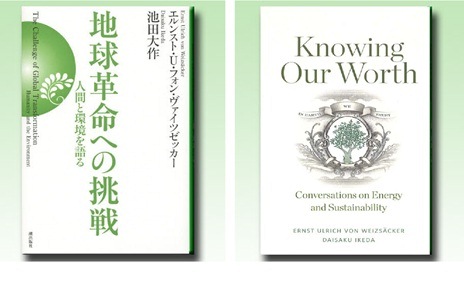
Fig. 4. Left: Interview collection "Challenge To the Global Revolution - Talk About Human Beings And the Environment -" by Weizsäcker and Ikeda Dialogue was published in Japan in 2014. Right: "Knowing Our Worth"- Conversations on Energy and Sustainability -by Weizsäcker and Ikeda was published in the US in 2016.
The joint exhibition, "Seeds of Hope - Visions of sustainability, steps toward change ", produced by SGI (Soka Gakkai International) and the Earth Charter International, has been held around the world (Fig.5). This exhibition shows that the wisdom of all ages and countries involved in the “sustainability" are "all related to each other." Also through this exhibition it explains that the environment is warning us that we are on the cusp of crisis of a global scale and that a "sustainable global society, begins from the human behavior of one person, begins from the reform of one person’s heart".
Daisaku Ikeda has been pointed out that the following. “When you focus on the area of the world, you will notice that the area of the city is only 2%.The city, occupies the entire world 75% of the carbon emissions, also more than 60 percent of energy consumption. Large environmental impact will occurred in cities of the world. From this fact, if the city has changed, there is a possibility that the world is greatly changed.” (D. Ikeda, "SGI's Day" commemoration proposal "Universal Respect for Human Dignity: The Great Path to Peace," January 26, 2016)
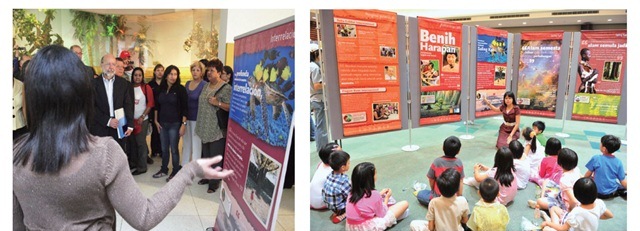
Fig. 5. "Seeds of Hope - Visions of sustainability, steps toward change" is held in the world
III. SPECIFIC METHODS
Our school stands on a hill in Hamamatsu-city which is situated between Tokyo and Osaka. In Hamamatsu-city, there are many factories like the well-known YAMAHA, HONDA and SUZUKI, and we are known as the city of motorcycles, musical instruments and industry. Since 1991, our school has been working on environmental education and activities based on “volunteer activities” and “manufacturing activities”. Our chief activities are 1) Volunteer Activities to protect the nature, 2) Careful Manufacturing Activities for nature and environment, 3) Practice of Global-Warming-Prevention Education, 4) Environmental Education Declaration (Fig.6), 5) Recycling Activity, 6) Eco-Tourism, 7) Environmental Education by NIE (Newspapers in Education), 8) Making Forests in 7 areas according to their potential natural vegetation (Fig.7), 9) Training of internal auditors of international environmental management system (ISO14001), 10) Practice of Disaster Prevention Education (to prepare for the Great Tokai Earthquake and nuclear power plant disaster; it is assumed that the Great Tokai earthquake would be even larger than the Great East Japan Earthquake occurred on 3/11/2011).

Moreover, we have worked on natural observation, investigation, nature conservation activities of Lake Hamana and Lake Sanaru which are closed coastal areas which contain both fresh and sea water. As an organization to promote these activities, PTA environmental education club, also junior eco clubs are founded.
At 14:46:18 local time on March 11, 2011 the most powerful earthquake ever recorded to have hit Japan struck off the coast of Japan’s Tohoku region. This magnitude 9.0 earthquake, referred to in Japan as the Great East Japan Earthquake, triggered a powerful tsunami generating waves from 10 meters up to 40.1 meters in height along the Japanese Pacific coast of the Tohoku and Kanto regions. 15,894 people were killed, 2563 people were reported as missing, and it led to the environmental disaster caused by the reactor meltdowns and release of radioactive material at TEPCO nuclear power plant in Fukushima. It was classified as a level 7 event on the International Nuclear Event Scale - the same as Chernobyl.2016 will mark the fifth anniversary of the Great East Japan Earthquake and Eastern Japan is preparing for what is being called a once in a thousand year earthquake emanating from the Nankai trough. It is expected to trigger a much larger tsunami than the one encountered on March 11th of 2011. In June of 2012, through donations and funding from Shizuoka Prefecture, Hamamatsu city, and private housing firm, Ichijo Co., Ltd, 300 million Yen was raised to build a seawall stretching 17.5km from Lake Hamanako to the Tenryu estuary. When finished it will stand 13 meters high and is being built using environmentally friendly materials. In cooperation with our citizens we are planting trees on its slopes to help protect the natural landscape and to keep any damage from the next tsunami to a bare minimum (Fig.8).
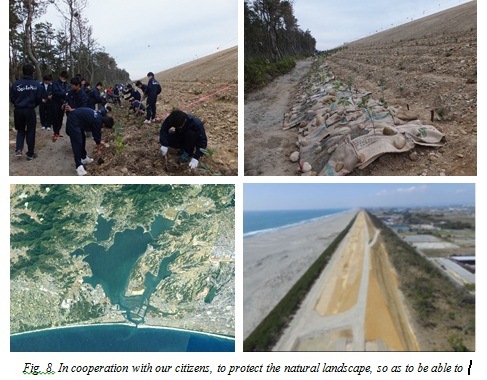
Risk management on a global scale due to Climate Change is a very important concern involving our children's future and happiness. Global-warming-prevention education is crucial for the survival of mankind. This is because there is a possibility of falling into a huge crisis that we won’t notice until it’s too late.
There is a worry that a massive magnitude 9 earthquake will occur in the near future in Shizuoka Prefecture in which we live. Nuclear power plants are located in our prefecture. A huge tsunami may badly damage them. It is assumed that the Great Tokai earthquake would be even larger than the Great East Japan Earthquake. It is estimated that the dead would exceed 100,000 people. We have learned a great many lessons from the past massive earthquake to prepare for the Great Tokai Earthquake and potential nuclear power plant disaster. Environmental education and Precautionary Principle are required for disaster prevention education (Fig.9). A course of the "global-warming-prevention seminar" course for local citizens is held at our school at night. Many college professors and college presidents in our area, specialists from companies, and the person in charge of the Global Warming Prevention Center come to our school as lecturers.

Many companies are asked for ethicality and morals all over the world. Moreover, the management systems of ISO14000 and ISO26000 are becoming a symbol of the world enterprise. Business and manufacturing organizations operate in the relationship to society and environment. It is a critical factor for their effective and sustainable operation. ISO26000 which requires much humanitarian and ethical management is becoming a main stream in the world year by year. This is completely in agreement with a prediction of Makiguchi who wrote it 110 years ago (Fig.10).
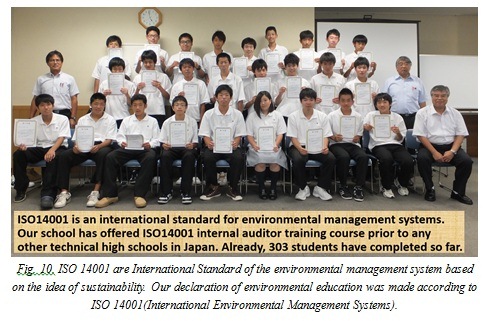
IV. CONCUSIONS
Through our school's creative environmental education activities, I have reached to the conclusion that the educational power of hometown's unique nature and people are very important for environmental education and activity (Fig.11). And our practical environmental education based on “A Geography of Human Life” has taught us for the last 25 years that Human-Revolution in only one person may also be able to cause Sustainable Earth Revolution, which global citizens find out the greatest value in nature and environment (Fig.12).
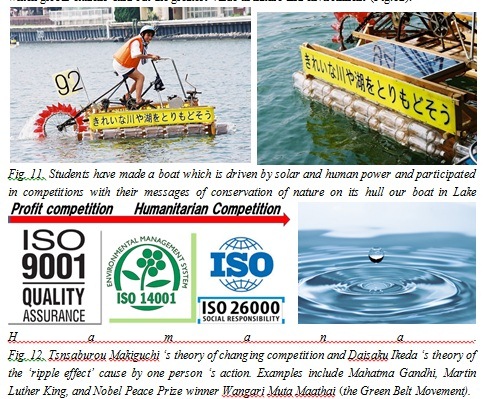
1. D. Ikeda, “The Human Revolution”, Seikyo Shinbunsha, Japan 1965 [Ningen Kakumei]
2. T. Makiguchi, “A Geography of Human Life”, Bunkaido, Japan 1903 [Jinsei Chirigaku]
3. T. Makiguchi, and D.M. Bethel (Editor), “A Geography of Human Life”, Caddo Gap Pr., 2002
4. T. Makiguchi, and D.M. Bethel (Editor), A. Birnbaum (Translator), “Education for Creative Living: Ideas and Proposals of Tsunesaburo Makiguch”, Iowa State Pr., 1989
5. E.U. von Weizsäcker, and D. Ikeda, “Challenge To the Global Revolution - Talk About Human Beings And the Environment -“,Ushio Publishing Co. Ltd. Japan, 2014.







